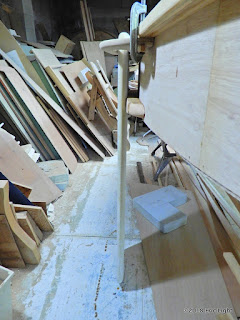I need to learn to re-read the instructions before I do something like this. The mast was supposed to be pine or something else light. I didn't get the message, and bought fir, which makes it really heavy. So I put a layer of cedar in-between two layers of fir. It'll be a very strong mast! Maybe I'll make it a bit smaller in diameter.
More than half of those clamps are John's, and he helped me to clamp it. Thanks, John! We put a string down the middle and eyeballed it for straight, taking out a curve by drilling long screws into the floor in key spots and putting wedges between the upright screws and the mast until it was straight.
I used Titebond III for this as well. It was 8º and the glue bottle says it needs at least 7º(C), so it's going to work fine.
Also
My
Polysail kit arrived today. Thanks, Dave!
Something I really like about the polysail is that it floats. I nearly lost my sister JoAnne's CL16 jib one time, as it sank really fast!
So, with the enclosed ends on the boat, the extra buoyancy the seats will add, and the buoyant sail with its wooden spars, this boat will not
turn turtle very easily. In the event of a capsize, it should lie on its side with most of the boat out of the water. The amount of water that will need to be bailed after righting should be minimal.
I think I'll save sail making for the really cold weather when it's just too cold to work in the unheated shop. I plan to make the sail in my apartment building lounge. Just don't tell anyone, okay?
😁
* I also need to look up words before I use them. I didn't realize that "avast" means to stop or cease!














